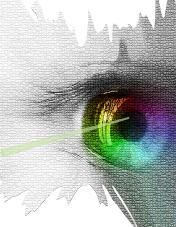|
Brillouin Microscopy The goal of this project is to develop and validate new biomedical imaging technology based on Brillouin light scattering for non-invasively measuring the biomechanical properties of tissues, cells, and biomaterials. Spontaneous Brillouin scattering arises from the interaction of light and sound wave that is inherently present in tissues and any matters. By detecting the spectral shifts in the scattered light, which are in the order of 10 GHz, the sample’s hypersonic viscoelastic properties can be measured at microscopic spatial resolution without physical contact. Brillouin spectroscopy has long been known in material physics and environmental sensing. However, its potential applications in biological sciences and clinical medicine had not been explored. We have developed a highly efficient spectrometer and demonstrated the possibility of in vivo Brillouin imaging. Brillouin technology may also be useful in the study of cellular biomechanics in cancer and tissue engineering. Brillouin imaging has a potential to be a useful diagnostic tool in ophthalmology for accurate detection and screening of various lens and corneal problems, such as presbyopia, cataracts, and corneal ectasia. Our technology has been spun off to a startup, Intelon Optics, for commercialization.
Relevant manuscripts 1. Confocal Brillouin microscopy for three-dimensional mechanical imaging. Nature Photonics 2008;2:39-43. 2. Cross-axis cascading of spectral dispersion. Optics Letters 2008;33:2979-81. 3. In vivo measurement of age-related stiffening in the crystalline lens by Brillouin optical microscopy. Biophysical Journal 2011;6:1539-45. (Cover article) 4. Multistage VIPA etalons for high-extinction parallel Brillouin spectroscopy. Optics Express 2011;19:10913-10922. 5. In vivo Brillouin optical microscopy of the human eye. Optics Express 2012;20:9197-9202. 6. Brillouin optical microscopy for corneal biomechanics. Investigative Ophthalmology Visual Science 2012;53:185-190. 7. Brillouin microscopy of collagen crosslinking: non-contact depth-dependent analysis of corneal elastic modulus. Investigative Ophthalmology Visual Science 2013;54:1418-1425. 8. Collagen crosslinking using rose bengal and green light to increase corneal stiffness. Investigative Ophthalmology Visual Science 2013;54:3426-3433. 9. Numerical model of optical coherence tomographic vibrography imaging to estimate corneal biomechanical properties. J R Soc Interface 2014 11:20140920. 10. Biomechanical characterization of keratoconus corneas ex vivo with Brillouin microscopy. Investigative Ophthalmology Visual Science 2014 55;7:4490-4495. 11. High-finesse sub-GHz-resolution spectrometer employing VIPA etalons of different dispersion. Optics Letters 2015;40:4436-4439 12. In vivo biomechanical mapping of normal and keratoconic corneas. JAMA Ophthalmology 2015;133:480-482. 13. Noncontact three-dimensional mapping of intracellular hydro-mechanical properties by Brillouin microscopy. Nature Methods 2015;12:1131-1134 14. Translating ocular biomechanics into clinical practice: current state and future prospects. Current Eye Research 2015;40:1-18 15. Shear Brillouin light scattering microscope. Optics Express 2016;24:319-328. 16. Line-scanning Brillouin microscopy for rapid non- invasive mechanical imaging. Scientific Reports 2016;6:35398. 17. Etalon filters for Brillouin microscopy of highly scattering tissues. Optics Express 2016;24:22232-22238. 18. Selective two-photon collagen crosslinking in situ measured by Brillouin microscopy. Optica 2016;3:469-472. 19. High-extinction VIPA-based Brillouin spectroscopy for mechanical characterization of turbid biological media. Applied Physics Letters 2016;108:203701. 20. Besner S, Scarcelli G, Pineda R, Yun SH. In vivo Brillouin analysis of the aging crystalline lens. Investigative Ophthalmology Visual Science 2016;57:5093-5100. |
















